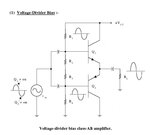Shayaan_Mustafa
Full Member level 5

- Joined
- Jan 16, 2011
- Messages
- 267
- Helped
- 0
- Reputation
- 0
- Reaction score
- 0
- Trophy points
- 1,296
- Activity points
- 3,213
First I have to amplify input around 12V and then add another section to amplify input above 12V. Right.
As we are using TL074 opamp in our discussion up til now. so second section should be same as current section. Should we use cascaded amplifiers?
As we are using TL074 opamp in our discussion up til now. so second section should be same as current section. Should we use cascaded amplifiers?

